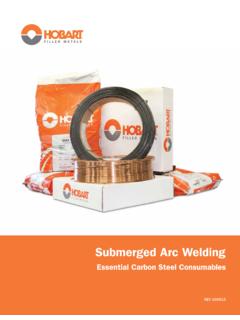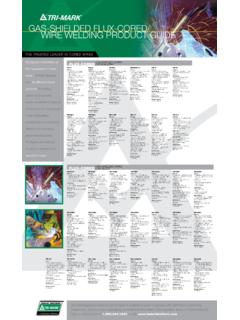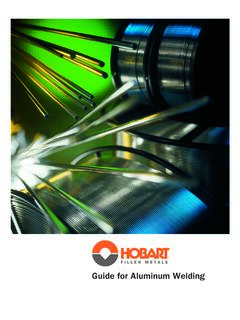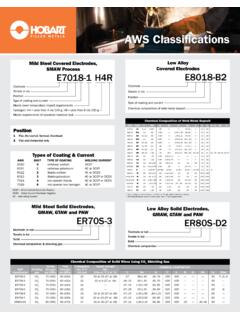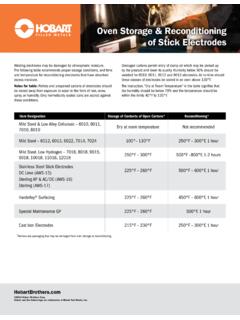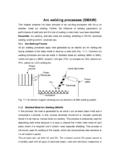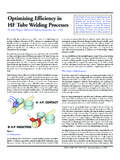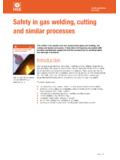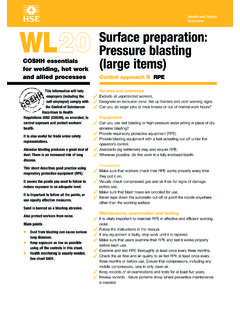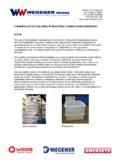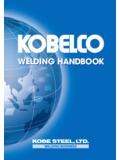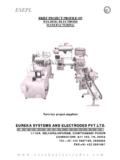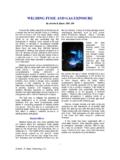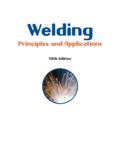Transcription of Helpful Hints to Basic Welding - Hobart Brothers
1 Helpful Hints to Basic Welding F O R E W O R D. This guide, and all the information contained within, is intended to provide you with Helpful Hints for Basic Welding . It is not intended as a comprehensive manual, nor does it contain the scope of information needed for commercial or industrial Welding purposes. If you are not familiar with the safety practices, procedures and techniques of Basic Welding , you will need to supplement this guide with additional reading material and/or enroll in a Basic Welding course. For any Welding that involves the protection of life, limb or property, always seek the services of a competent professional welder. T A B L E O F C O N T E N T S. Everyday Welding Welding Stick or Wire: Which is Your Welding Preference?..4. Basic Stick Welding A Quick Stick Equipment and Setting the Striking an Electrode Arc Travel 7 Factors in Selecting Arc Welding Filler Metals Selector Examples of Good and Bad Stick Wire Welding A Quick Wire Equipment and Wire Wire Feed Speed and Initiating an Electrode Electrode Welding Gun Travel Shielding Gases and Their Welding Examples of Good and Bad Wire 1.
2 EVERYDAY Welding APPLICATIONS. Welding is an efficient and easy way to cut down on maintenance or repair costs associated with metal equipment around the house or farm. Through Welding , you can repair a wide variety of things including: Home Improvement Lawnmower decks and handles Ductwork Fencing Steel patio furniture Garage door tracks and brackets Wheelbarrows Recreation Basketball rims and posts Swing sets Harrow disk repair with Hobart 335A. Trampolines stick electrodes Wagons Snowmobile skis and skags Bicycles and tricycles Agricultural Combines Grain wagons Balers Farm equipment frames Tractors and trailers Galvanized roofing Trailer hitches Trailer frames and sides Four-wheeler repair with Hobart 's HB-28 solid wire Automotive Tailpipes Motorcycles Bumpers Trailer hitches Auto bodies and door brackets Helpful Hint #1.
3 Before starting any Welding project, be sure you read about Welding safety! 2. Welding SAFETY. Always remember Welding is serious business! Make sure you protect yourself by following these important safety tips: Always wear protective clothing! Wear a heavy cotton shirt, cuffless trousers, high shoes and a cap to protect yourself while Welding or removing slag. Always wear a Welding helmet with visor shade #10. or darker! Arc rays from the Welding process produce intense visible and invisible (ultraviolet and infrared) rays that can burn eyes and skin. NEVER WELD. WITHOUT PROPER EYE PROTECTION! Always wear safety glasses! Wear safety glasses with side shields to protect your eyes while Welding and removing slag. Always wear leather Welding gloves! Wear gloves to protect your hands and wrists from hot sparks and radiation burns while Welding and removing slag.
4 Weld in a well-ventilated area fumes and gases can be hazardous! Welding may produce fumes and gases that can make you ill. Be sure to keep your head out of the fumes do not breathe the fumes! Keep weld area free of flammables! Move paint, solvent, gasoline, paper products and other flammables away from the weld area so they won't catch fire from sparks and hot slag. 3. Protect others! Set up protective screens or barriers to protect other persons from flash and glare; warn others not to watch the arc. When Welding small parts, do not weld on the garage floor or driveway use a Welding table! The heat generated by the electric arc can cause cement to explode or set asphalt on fire. Do not weld on tanks or containers that previously held flammable materials! Even though it may be empty, a tank or container that previously held a flammable material may still contain combustible vapors or residue that can result in an explosion.
5 Be familiar with your Welding equipment! Understanding how to properly operate Welding equipment protects you from harm and your equipment from damage. Helpful Hint #2. To learn more about Basic Welding , call the Hobart Institute of Welding Technology! For course information, call or , or visit their web site at STICK OR WIRE: WHICH IS YOUR. Welding PREFERENCE? There are several different Welding processes that are ideal for projects around the house of farm: Stick Welding properly known as SMAW (Shielded Metal Arc Welding ). Wire Welding properly known as GMAW (Gas Metal Arc Welding ) or FCAW (Flux-cored Arc Welding ). All of these processes involve the joining of metals by means of an electric arc. This electric arc, at a temperature of about 10,000 F, melts both the metal electrode and the base metal (the metal being welded) together, producing a molten weld puddle that quickly solidifies to form the weld.
6 4. S T I C K W E L D I N G. Although these processes depend on the use of an electric arc, they differ in technique, including the type of electrode and equipment required. Stick Welding is a manual arc Welding process in which a covered metal stick electrode is used as the filler metal for making the weld. Wire Welding is considered as a semi-automatic process, Front-end loader repair with Hobart 18AC. using a wire electrode that's stick electrode conveniently fed through a Welding gun. Stick Welding requires you to have more skill because you have to consistently concentrate on the electrode while you are Welding , keeping it in the proper Welding position and manually maintaining the proper arc length as the Repairing farm equipment using Hobart 's electrode gets shorter. Champion and 418 stick electrodes. Wire Welding is considered to be somewhat easier than stick Welding because the Welding gun continuously feeds the wire while you weld, allowing you to focus on gun position for maintaining the proper arc length.
7 Plus, you don't have to worry about the electrode getting shorter. Whether you prefer stick Welding or wire Welding . the Welding process you use is most likely the one you have the most experience with or have the equipment for. Stick Welding (properly known as Shielded Metal ELECTRODE. Arc Welding or HOLDER. SMAW) requires use of a covered METAL ROD. STICK ELECTRODE. stick electrode, a metal rod that's WELD BEAD FLUX COATING. SLAG. coated with a GAS SHIELDING. material called ELECTRIC ARC. GROUNDED. WORKPIECE. flux. An electrode holder is used to MOLTEN WELD PUDDLE. hold and supply current to the stick electrode, causing it to melt and deposit molten metal. As the electrode melts, the flux coating breaks down to perform several functions: 1) form a gas shielding 5. S T I C K W E L D I N G. to protect the weld puddle from the air, 2) keep the weld puddle clean from contaminants, and 3) produce a light, protective coating, called slag, over the weld.
8 The slag is removed by tapping the weld with a chipping hammer or chisel and cleaned off with a wire brush. Stick electrodes ideal for various home and farm Welding projects include 5-lb. Plastic Paks of Hobart Hobart 's 335A, 18AC, 418 and 447A. stick electrodes These premium stick electrodes are great for many different applications and come in a variety of diameter sizes. For a list of product applications, see pages 10-11. Equipment and Tools In stick Welding , the equipment and tools that are required are: power source Welding machine . complete with Welding cable, electrode holder and ground cable and clamp chipping hammer or chisel, and a wire brush (for removing slag). protective clothing including helmet and gloves Repairing farm fencing in the field using Hobart 's 418 stick electrodes Helpful Hint #3.
9 If you have to use an extension cord to get power to your Welding equipment, make sure the cord is the correct size to carry the current from the outlet to the power supply! Techniques To produce a good quality weld, it is important to master the following stick Welding techniques. the first thing you should do before you start Welding is make sure the workpiece the item you are Welding is as clean as possible. Use a clean cloth, wire brush or sandpaper to remove any rust, dirt, paint, grease, oil or other contaminant. Do not use cleaning solvents because you can run the risk of an explosion or fire, or Great for many applications, Hobart 18AC features a smooth, stable illness from toxic vapors. arc and offers excellent re-striking capabilities. 6. S T I C K W E L D I N G. Helpful Hint #4. Be sure to connect the ground clamp of your Welding equipment to the workpiece before you start Welding !
10 Setting the Amperage Select the proper amperage based on the specifications of the stick electrode. Sometimes, you may find that you have to fine tune the setting so that the electrode melts properly. The best way to check this is to perform some test welds on some scrap metal and look at the weld. If you notice that the weld is . piling up or you see signs of burn-through (holes in the base metal), then the amperage is probably set too high;. not penetrating the joint (little depth) or not fusing to the workpiece (doesn't cover joint walls) properly, then the amperage is probably set too low. Striking an Arc To strike an electric arc, bring the tip of the stick electrode near where you want to start the weld. Almost like striking a match, strike the stick electrode slightly across the workpiece until you have established an arc.

